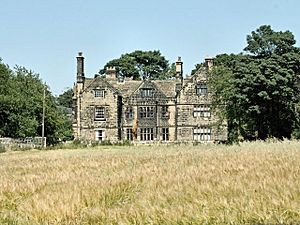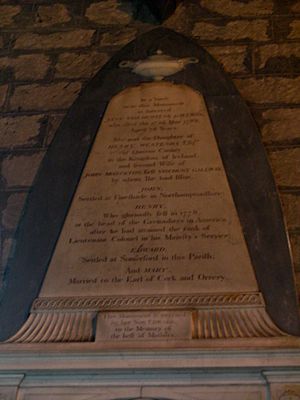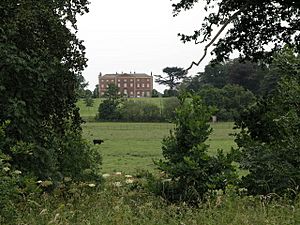John Monckton, 1st Viscount Galway facts for kids
Quick facts for kids
The Viscount Galway
|
|
|---|---|
| Member of Parliament for Pontefract | |
| In office 1749–1751 Serving with George Morton Pitt
|
|
| Preceded by | George Morton Pitt William Monckton |
| Succeeded by | George Morton Pitt William Monckton |
| In office 1734–1747 Serving with Sir William Lowther, 2nd Baronet, George Morton Pitt
|
|
| Preceded by | Sir William Lowther, 2nd Baronet John Mordaunt |
| Succeeded by | George Morton Pitt William Monckton |
| Member of Parliament for Clitheroe | |
| In office 1727–1734 Serving with Thomas Lister
|
|
| Preceded by | Thomas Lister Nathaniel Curzon |
| Succeeded by | Thomas Lister William Curzon |
| Personal details | |
| Born |
John Monckton
1695 |
| Died | 15 July 1751 (aged 55–56) |
| Political party | Whig |
| Spouses |
Lady Elizabeth Manners
(died 1730)Jane Westenra
(m. 1734) |
| Children | William Monckton-Arundell, 2nd Viscount Galway Robert Monckton John Monckton Henry Monckton Edward Monckton Mary Boyle, Countess of Cork and Orrery |
| Parents | Robert Monckton Theodosia Fountaine |
| Residences | Hodroyd Hall Serlby Hall |
| Alma mater | Trinity Hall, Cambridge |
John Monckton (1695 – 15 July 1751) was an important British landowner and politician. He was a member of the Whig political party. He served in the House of Commons from 1727 to 1751. In 1727, he was given the special title of the first Viscount Galway.
Contents
Early Life and Family
John Monckton was born in 1695. His parents were Theodosia Fountaine and Robert Monckton. His father, Robert, owned large estates like Cavil and Hodroyd in Yorkshire.
Robert Monckton was against the policies of King James II. He went to the Netherlands and returned with William III during the Glorious Revolution of 1688. This event changed who was king in England.
Because of his father's actions, the Monckton family became strongly connected to the Whig party. Robert Monckton later became a Member of Parliament (MP) himself.
John Monckton studied at Trinity Hall, Cambridge starting in 1713.
Political Career
John Monckton first tried to become an MP for Clitheroe in 1722. He didn't win that election. At the time, winning a seat often depended on owning special properties called burgages. These properties gave people the right to vote.
Monckton bought some burgages but still didn't win. So, he sold them to Sir Nathaniel Curzon. As part of their agreement, Curzon helped Monckton win the Clitheroe seat in the next election.
In 1727, John Monckton was elected MP for Clitheroe. The government, led by Robert Walpole, was grateful for his support. On 17 July 1727, they gave him the title of Viscount Galway and Baron of Killard. These were Irish titles. Having an Irish title meant he could still serve in the British Parliament. This was a way to honor important political friends.
Becoming an MP for Pontefract
In 1729, Lord Galway bought 77 burgages in Pontefract. This was his father's old voting area. He spent £6,000 on these properties. This purchase gave him and Sir William Lowther control over the borough. They agreed to each choose one MP for future elections.
When his time as MP for Clitheroe ended in 1734, Lord Galway was elected MP for Pontefract. He served alongside Sir William Lowther.
Government Roles
Lord Galway also held important government jobs. In 1734, he became a Commissioner of Revenue in Ireland. He held this job until 1748. This role involved managing government money.
He was re-elected as MP for Pontefract in 1741. In 1747, his eldest son took over his seat. However, Lord Galway returned as MP for Pontefract in 1749. He did this to get another profitable government job.
In 1749, the Prime Minister, Henry Pelham, suggested Lord Galway for a new role. This role was Surveyor-General of Lands, Woods and Forests in England and Wales. Pelham was Lord Galway's brother-in-law. He noted that Galway had spent a lot of money to become an MP and even bought a borough.
Lord Galway held the Surveyor-General job and remained MP for Pontefract until he passed away in 1751.
Family Life
John Monckton was married twice. His first wife was Lady Elizabeth Manners. She was the daughter of John Manners, 2nd Duke of Rutland. They had two sons:
- William Monckton-Arundell (1725–1772), who became the 2nd Viscount Galway.
- Robert Monckton (1726–1782), who became a well-known Army General.
After Lady Elizabeth passed away in 1730, Lord Galway married Jane Westenra in 1734. She was from Ireland. Together, they had four children:
- John Monckton (1739–1830).
- Henry Monckton (1740–1778), an army officer.
- Edward Monckton (1744–1832), who also became an MP.
- Mary Monckton (1748–1840), who became a famous hostess for writers and politicians.
Lord Galway died on 15 July 1751. His second wife, Lady Galway, lived until 1788.
Family Estates
When his father died in 1722, John Monckton inherited Hodroyd Hall. This had been the Monckton family home since the early 1600s.
In 1725, he bought the Serlby estate in Nottinghamshire. He then started building a new family home called Serlby Hall. He also collected many important paintings there. He was a member of the Society of Dilettanti, a group interested in art and ancient Greek and Roman culture.




